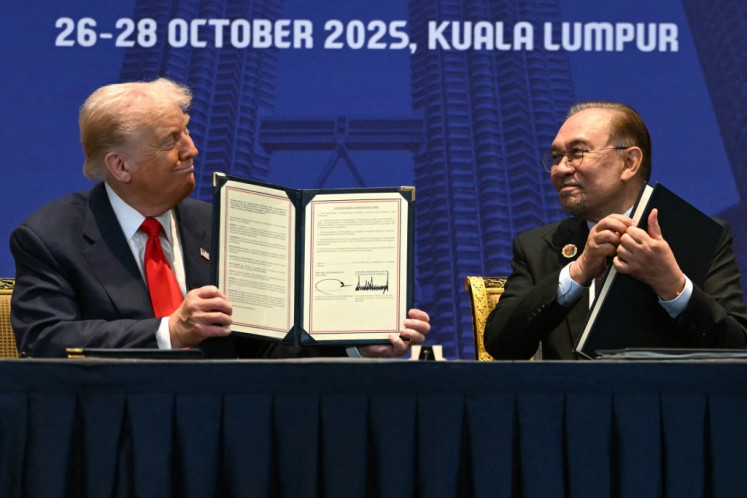Popular Reads
Top Results
Can't find what you're looking for?
View all search resultsPopular Reads
Top Results
Can't find what you're looking for?
View all search resultsIs Asia-Pacific private equity on the rebound?
After a two-year slumber following a decade of record capital inflows, private equity (PE) in the Asia-Pacific region posted a surprisingly strong start in 2014
Change text size
Gift Premium Articles
to Anyone
A
fter a two-year slumber following a decade of record capital inflows, private equity (PE) in the Asia-Pacific region posted a surprisingly strong start in 2014. Investment value in the first quarter shot up to US$22 billion, more than double the total over the same period last year. Exit value improved in several important markets, and a number of large investors appeared poised to increase their commitments to PE firms operating in the region.
As always, the headline numbers don't tell the entire story. The early-year surge lacked breadth and was dominated by a number of megadeals, including Temasek Holdings's $5.7 billion agreement to acquire one-quarter of Hong Kong retailer AS Watson Group in March. Deal value has also slacked off somewhat in recent months ' the second quarter has so far been less impressive than the first.
But even if increased deal activity comes in fits and starts, what's most encouraging is that the PE industry is finally beginning to recycle capital ' a necessary prerequisite to restoring healthy long-term growth. As the industry works its way through a crucial multiyear transition, the increases in deal value and exit activity are important signs of progress.
Though the various Asia-Pacific economies remain among the most attractive emerging markets in the world, the PE industry has been suffering the aftereffects of a pre-2011 investment boom and subsequent economic slowdown ' most notably in China.
As competition for attractive target companies has grown, valuations have skyrocketed, making it difficult for PE firms to pare down mountains of unspent capital. And a combination of economic uncertainty and volatile markets for initial public offerings has dampened exit activity, limiting distributions to investors and discouraging new capital commitments.
But 2014's early spike of activity suggests the market may be moving past these imbalances, albeit slowly. In addition to the jump in deal value, the first quarter produced $19 billion worth of exits, or 42 percent of 2013's full-year total, returning significant capital to increasingly impatient PE investors.
With the exception of Southeast Asia, which has seen little exit activity so far this year, the improvement in exits has been widespread. China rebounded strongly after a dismal year in 2013, with $5.6 billion in IPO exits during the first quarter and $3 billion so far in the second, including JD.com's $1.78 billion deal, which provided exits for a consortium of PE firms and hedge funds.
The fresh return of capital provides significant relief to investors who have piled record amounts of money into the region with little to show for it so far. Scant distributions have left many over-allocated in markets like China and India.
But as PE activity heats up in the Asia-Pacific region, investors may be increasingly eager to boost allocations to the asset class and consider anew how to take advantage of the region's growth. According to a May 2014 AMP Capital/Institutional Investor Research Report, 35 percent of global investors focused on the Asia-Pacific region plan to boost their PE allocations to the region this year.
A number of massive institutional investors in the region are also now targeting PE with larger portions of their portfolios. China Investment Corporation, for instance, is increasing its percentage allocation to PE, as are large Korean funds, such as the pension arm of South Korea's postal service, Korea Post.
Meanwhile, Japan's $1.2 trillion Government Pension Investment Fund (GPIF), the world's largest pension investor, is taking steps to boost its performance by shifting a percentage of its massive portfolio to alternative asset classes, including PE. Given that GPIF's assets under management are roughly equivalent to the gross domestic product of South Korea, even a small shift toward PE could make a big difference.
Coming off the recent down period, investors have become increasingly selective about which PE firms they trust with their money. A pronounced flight to quality is taking place, which has strongly favored the best-performing firms.
This shift in behavior among investors is precipitating a shakeout of underperforming funds, which will ultimately benefit the market by normalizing competition for deals and boosting average returns.
But the PE firms that weather this transition will have to progressively raise their game. The best are sharpening their investment model by taking a more activist approach to deals and more closely defining where they create the most value. They are insisting on a seat at the table at their target companies, so they can stay actively involved throughout the ownership period.
Like their investors, they are also extending their geographic focus as they search for potential deals. And they are diversifying their risk by opening their portfolios to a broader set of investment vehicles, such as real estate, infrastructure, hedge funds and public equity.
What's clear is that the opportunity in the Asia-Pacific region remains extraordinary. Despite this period of sluggishness for the PE industry, the region's diverse set of economies still outperforms the global average, powered by rapid development and modernization.
As the market recovers, however, more new capital will flow to a fewer number of PE firms. Investors are already making their choices. Winning their trust will require PE firms to be crystal clear about how they will source the best deals, create the most value and deliver the best returns.
__________________________
Suvir Varma is a Bain & Company partner who leads the firm's Asia-Pacific Private Equity practice, and Johanne Dessard is a practice-area manager on the Private Equity practice.










